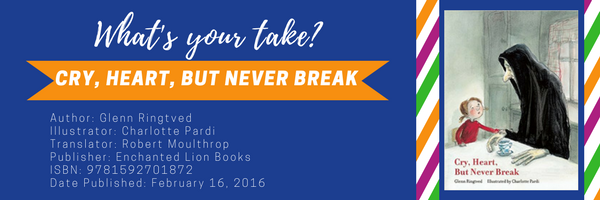
Compiled by Janelle Mathis
The My Take/Your Take for April is aligned with the upcoming WOW Review issue on picturebooks. The participants here are all part of a doctoral seminar at the University of North Texas focused on Critical Content Analysis of International Children’s and YA Literature, and as a result of this course, they are discovering new picturebooks that call for different perspectives and insights. Several books from varying award and honor lists have caught the attention of these educators and they share their responses here.

Cry, Heart, but Never Break (2016) is the first book to which responses come from three educators: Brett, a middle school teacher; Sara, an international student from Saudi Arabia; and Traci, a Graduate/Teaching Assistant who teaches literacy and children’s literature. This first text is the winner of the 2017 Mildred L. Batchelder Award given by the American Library Association for translation. It was originally published in Danish in 2001 as Græd blot hjerte. Published by Enchanted Lion Books, the story tells of four young children who have been raised by their grandmother. Grandmother is old and finally Death arrives to take her in a very natural, calming manner. The children try to outwit Death throughout the night to avoid losing Grandmother. However, when the inevitable time approaches, Death uses an allegory about the marriage of sadness and grief to two young women, happiness and joy, and tells how the couples decided that they could not ever live apart.
BRETT: Cry, Heart, but Never Break is a lovely book that gives a soft exposure to a heavy topic of death. It delicately presents the positives and negatives in an almost mythological tale with how joy and grief and sorrow and delight came together to live in peace and harmony. Death is made a real and relatable character as he seems to almost avoid the task of ushering the grandmother’s soul to the beyond as he sits and enjoys coffee with the young children and imparts wisdom for them to live by. He leaves them, not only with the remembrance of amazing memories of their grandmother but with that wisdom on how those polar feelings of sorrow and delight, joy and grief carry them through.
This would make a great family shared book. I would recommend caution in sharing this book in the context of a school classroom as many families hold death and what comes after as sacred and has cultural and religious connections that may or may not be represented.
SARA: As a culture, it seems Americans do not prefer for their kids to be exposed to death. However, this is a heavy handed but lighthearted book about grief and death for children. It is helpful in taking away the fear and darkness that is associated with death. Death cannot be softened or hidden; nevertheless, this book made it understood as fact and part of our natural world.
Death is the main character who plays an integral role in helping the children accept his presence as a natural part of the life cycle and not a scary or unreal thing. I think the author was successful in writing about this sensitive topic because he made it an informative story about death. Although the four kids in the story felt the shadow of sadness because they are seeing their grandmother pass away, they are taught by death that delight and joy and sorrow and grief do come together in our lives. Moreover, it teaches children how to handle the grief of a loved one who passes away.
Furthermore, another important lesson for children exists when Death says, “What would life be worth if there were no death?” Death teaches the four kids to value what they have and to not take things for granted. I consider this book as a precious addition to children’s books about understanding death, and I would highly recommend it for teaching about grief to young children.
TRACI: When I first saw the cover of Cry, Heart, but Never Break, I didn’t know what to expect. The picture of “Death” on the cover of a children’s book startled me, and I wondered how Glenn Ringtved could take a symbol usually found in horror movies and make a story for children out of it. Fortunately, he does so in a remarkable way.
I agree with Brett and Sara that this story teaches children about death with a gentle and understandable parable of Sorrow, Grief, Delight and Joy. The children, from the beginning, are sad but not afraid when Death comes to visit them. He is not frightening due to his sympathetic demeanor and the quiet way that he talks to the children. At the end of the story, the children understand that life is more precious because we know that it will eventually come to an end.
The story refers to the grandmother’s soul leaving her body and the children believe that the grandmother is watching over them after her death. Like Brett and Sara said, this book may be best for families dealing with the death or imminent death of a loved-one. However, in my years of teaching, I have had three young students lose their lives during the school year. I wish that this book had been available to me at those times to help my students deal with the death of their classmates. Children’s books about death are often of a religious nature. In my opinion, Cry, Heart, but Never Break is a book that could be safely used in schools because of the fictional and metaphorical aspects of the story. However, Brett is correct in saying that teachers should be sensitive to student beliefs if this book is read.
Title: Cry, Heart, but Never Break
Author: Glenn Ringtved
Illustrator: Charlotte Pardi
Translator: Robert Moulthrop
Publisher: Enchanted Lion Books
ISBN: 9781592701872
Date Published: February 16, 2016
This is the first installment of April’s My Take/Your Take. To follow the whole conversation, check the WOW Blog every Wednesday.
- Themes: Janelle Mathis
- Descriptors: Awards, Books & Resources, My Take/Your Take
